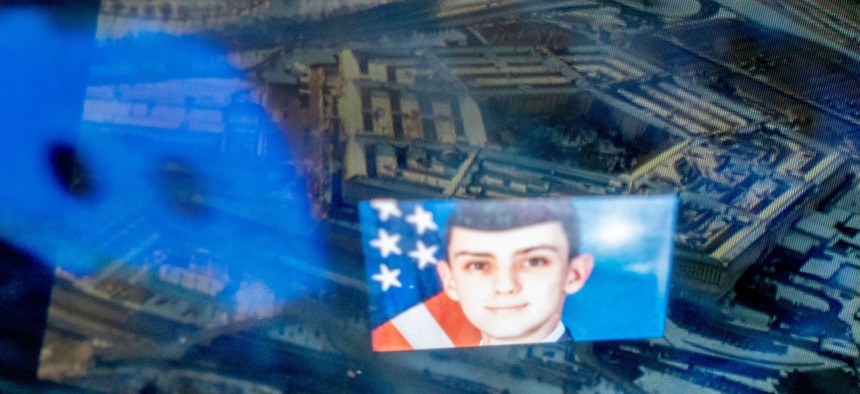
2023's Discord leaks, allegedly by national guardsman Jack Teixeira, put a harsh spotlight on the vetting process for obtaining a security clearance. STEFANI REYNOLDS / Getty Images
Catastrophic leaks and wild reforms mark the 2023 security clearance year in review
COMMENTARY | The Discord leaks helped put a starker spotlight on the security clearance process, bringing more scrutiny at a time when demand for cleared personnel has intensified and processing times have swelled.
For those looking for stability to arrive to the national security hiring market – 2023 was not the year. While reform efforts continued to barrel forward, so did another catastrophic leak of classified information, creating more distrust of the U.S. security apparatus and calls for everything from fewer security clearance holders to criminalizing any reference to having a security clearance.
Here are the top security clearance trends from 2023, in brief:
- The Jack Teixeira Leak
The Discord leaks didn’t just compromise our position with our allies, it caused even more widespread criticism of the security clearance and personnel vetting process. An internal investigation demonstrated that alleged leaker Jack Teixeira had a pattern of failing to follow proper procedures around protecting classified information, with several incidents documented. The Air Force recently announced that fifteen individuals were disciplined in response to the Teixeira leaks. But that hasn’t stopped critics from calling the entire security clearance process into question, and many asking how Teixeira was able to obtain a security clearance in the first place.
- Crazy Ideas in Congress
Attempts to villainize the intelligence community workforce don’t seem to go away – at least where Congress is concerned. Congress was already putting classified information protection in the spotlight, thanks to Donald Trump’s classified information issues, which seemed to create a trickle-down effect where it seemed almost everyone was storing information they shouldn’t, in places they shouldn’t (at least if you were a former president or vice president).
The Classification Reform Act and Sensible Classification Act were both proposed over the summer. Aspects of each of the bills then found their way into the fiscal 2024 National Defense Authorization Act. In addition to efforts to declassify documents more quickly, the legislation also asks agencies to justify their cleared population, in an effort to reduce the overall number of individuals with a security clearance.
Another piece of outlier legislation, the Security Clearance Revolving Door Act of 2023 was introduced in October and seeks to impose criminal penalties on anyone who publicly discloses if they have a national security clearance. The bill labeled itself as an attempt to curb the “Deep State.”
- Continued cleared talent shortage.
Lost in the statements made by senators arguing that security clearances are being given out like “candy” and attempting to penalize those who choose to protect national security is the reality anyone trying to hire a cleared professional will tell you – there are currently more positions out there that require individuals with security clearances than eligible and willing candidates to fill them. The issue is often how contracts are written. Contracts frequently make clearance, degree and skills requirements that ensure only those already in the industry are eligible. That incentivizes poaching across contractors rather than onboarding new entry-level talent to fill positions.
- An uptick in security clearance processing times.
Directly related to keeping the supply chains of cleared talent are open are the current security clearance processing times for new talent. While approximately 88% of individuals applying for a Department of Defense security clearance are able to obtain an interim clearance, those who need a fully adjudicated clearance to do the job are currently waiting an average of 170 days for a Top Secret clearance and 100 days for a Secret clearance – and that’s for the fastest 90% of applicants.
Slower security clearance processing times aren’t a major issue when there is enough market elasticity to cover openings. But because an overall talent shortage remains an issue, and government contract requirements continue to pigeonhole contractors, any uptick in security clearance processing times also creates more strains on employers – and prompts more candidates to jump ship and pursue private sector opportunities rather than sitting around waiting for a final determination and the real work to begin.
- NBIS
It’s a four-letter acronym, and it’s caused some across the personnel vetting process to mutter a few different four-letter words along the way. The underpinning of Trusted Workforce 2.0 is the full implementation of the National Background Investigation Services, the IT system designed to replace the more than 50-year old IT system once held by the Office of Personnel Management – and famously hacked into by China. Unfortunately, the roll-out of this new IT system hasn’t been without delays, and criticism. Those in the personnel security process hope it stays on track to keep the other elements of reform – including Continuous Vetting 2.0 and the Personnel Vetting Questionnaire (an overhaul of the current security clearance application forms, the SF-86, SF-85, and SF-85P) rolling out.
One bright spot in the security clearance reform process – ongoing efforts by the government to destigmatize mental health treatment appear to have taken hold, and many applicants report positive experiences with both disclosing mental health issues in their national security workplaces along with access to the resources they need. Stigma remains an issue, but when it comes to confusion about both the mental health question on the SF-86 and the fears around seeking proactive mental health treatment as an already-cleared professional, the momentum is shifting in a positive direction.
This year was (another) filled with big leaks and incremental shifts in policy thanks to the government’s Trusted Workforce 2.0 effort. Next year could be when the rubber meets the road and clearance reform initiatives take hold. Or change could get stuck in the quagmire of moving the monoliths of government and national security – two stones often very difficult to shift without the right leverage.






